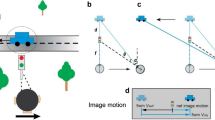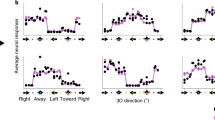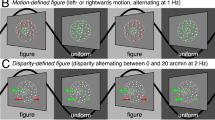Abstract
We see the world as three-dimensional, but because the retinal image is flat, we must derive the third dimension, depth, from two-dimensional cues. Image movement provides one of the most potent cues for depth1,2,3,4,5,6. For example, the shadow of a contorted wire appears flat when the wire is stationary, but rotating the wire causes motion in the shadow, which suddenly appears three-dimensional. The neural mechanism of this effect, known as ‘structure-from-motion’, has not been discovered. Here we study cortical area MT, a primate region that is involved in visual motion perception. Two rhesus monkeys were trained to fixate their gaze while viewing two-dimensional projections of transparent, revolving cylinders. These stimuli appear to be three-dimensional, but the surface order perceived (front as opposed to back) tends to reverse spontaneously. These reversals occur because the stimulus does not specify which surface is in front or at the back. Monkeys reported which surface order they perceived after viewing the stimulus. In many of the neurons tested, there was a reproducible change in activity that coincided with reversals of the perceived surface order, even though the stimulus remained identical. This suggests that area MT has a basic role in structure-from-motion perception.
This is a preview of subscription content, access via your institution
Access options
Subscribe to this journal
Receive 51 print issues and online access
$199.00 per year
only $3.90 per issue
Buy this article
- Purchase on Springer Link
- Instant access to full article PDF
Prices may be subject to local taxes which are calculated during checkout




Similar content being viewed by others
References
Rogers, B. J. & Graham, M. E. Similarities between motion parallax and stereopsis in human depth perception. Vision Res. 22, 261–270 (1982).
Miles, W. R. Movement interpretations of the silhouette of a revolving fan. Am. J. Psychol. 43, 392–405 (1931).
Wallach, H. & O'Connell, D. N. The kinetic depth effect. J. Exp. Psychol. 45, 205–217 (1953).
Ringach, D. L., Hawken, M. J. & Shapley, R. Binocular eye-movements caused by the perception of 3-dimensional structure-from-motion. Vision Res. 36, 1479–1492 (1996).
Siegel, R. M. & Andersen, R. A. Perception of three-dimensional structure from motion in monkey and man. Nature 331, 259–261 (1988).
Andersen, R. A. & Siegel, R. M. in Signal and Sense: Local and Global Order in Perceptual Maps (eds Edelman, G. M., Gall, W. E. & Cowan, W. M.) 163–184 (Wiley, New York, 1990).
Maunsell, J. H. & Van Essen, D. C. Functional properties of neurons in middle temporal visual area of the macaque monkey. II. Binocular interactions and sensitivity to binocular disparity. J. Neurophysiol. 49, 1148–1167 (1983).
Bradley, D. C., Qian, N. & Andersen, R. A. Integration of motion and stereopsis in middle temporal cortical area of macaques. Nature 373, 609–611 (1995).
Snowden, R. J., Treue, S., Erickson, R. G. & Andersen, R. A. The response of area MT and V1 neurons to transparent motion. J. Neurosci. 11, 2768–2785 (1991).
Hildreth, E. C., Ando, H., Andersen, R. A. & Treue, S. Recovering three-dimensional structure from motion with surface reconstruciton. Vision Res. 35, 117–137 (1995).
Nawrot, M. & Blake, R. Aneural network model of kinetic depth. Visual Neurosci. 6, 219–227 (1991).
Treue, S. & Maunsell, J. H. R. Attentional modulation of visual-motion processing in cortical areas MT and MST. Nature 382, 539–541 (1996).
Newsome, W. T., Britten, K. H. & Movshon, J. A. Neuronal correlates of a perceptual decision. Nature 341, 52–54 (1989).
Logothetis, N. K. & Schall, J. D. Neuronal correlates of subjective visual perception. Science 245, 761–763 (1989).
Braddick, O. Segmentation versus integration in visual-motion processing. Trends Neurosci. 16, 263–268 (1993).
Acknowledgements
We thank B. Gillikin and S. Gertmenian for technical assistance and F. Crick and C.Koch for comments on the manuscript. Supported by grants from the National Eye Institute, the Human Frontier Science Program, and the Sloan Foundation for Theoretical Neurobiology.
Author information
Authors and Affiliations
Corresponding author
Rights and permissions
About this article
Cite this article
Bradley, D., Chang, G. & Andersen, R. Encoding of three-dimensional structure-from-motion by primate area MT neurons. Nature 392, 714–717 (1998). https://doi.org/10.1038/33688
Received:
Accepted:
Issue Date:
DOI: https://doi.org/10.1038/33688
This article is cited by
-
Visual motion perception as online hierarchical inference
Nature Communications (2022)
-
A neural correlate of perceptual segmentation in macaque middle temporal cortical area
Nature Communications (2022)
-
Dynamic Visual Cues for Differentiating Mirror and Glass
Scientific Reports (2018)
-
Dorsal and ventral stream contributions to form-from-motion perception in a patient with form-from motion deficit: a case report
Brain Structure and Function (2017)
-
Reconstruction system of individual virtual model based on user interaction
Fibers and Polymers (2015)
Comments
By submitting a comment you agree to abide by our Terms and Community Guidelines. If you find something abusive or that does not comply with our terms or guidelines please flag it as inappropriate.



